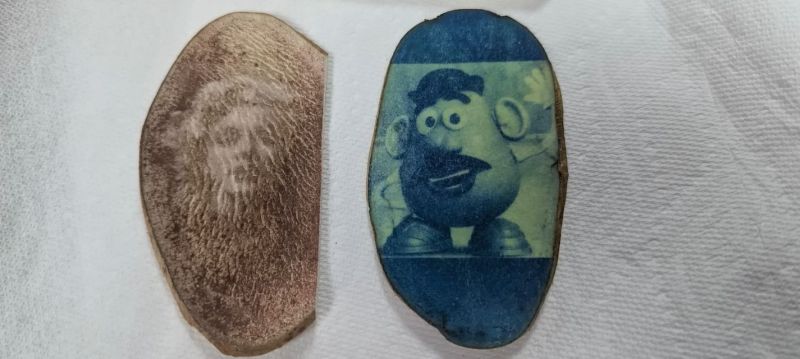Following in the tracks of unconventional science projects, [The Thought Emporium] seeks to answer the question of whether you can use a potato as a photograph recording medium. This is less crazy than it sounds, as ultimately analog photographs (and photograms) is about inducing a light-based change in some kind of medium, which raises the question of whether there is anything about potatoes that is light-sensitive enough to be used for capturing an image, or what we can add to make it suitable.
Unfortunately, a potato by itself cannot record light as it is just starch and salty water, so it needs a bit of help. Here [The Thought Emporium] takes us through the history of black and white photography, starting with a UV-sensitive mixture consisting out of turmeric and rubbing alcohol. After filtration and staining a sheet of paper with it, exposing only part of the paper to strong UV light creates a clear image, which can be intensified using a borax solution. Unfortunately this method fails to work on a potato slice.
The next attempt was to create a cyanotype, which involves covering a surface in a solution of 25 g ferric ammonium oxalate, 10 g of potassium ferricyanide and 100 mL water and exposing it to UV light. This creates the brilliant blue that gave us the term ‘blueprint’. As it turns out, this method works really well on potato slices too, with lots of detail, but the exposure process is very slow.
Speeding up cyanotype production is done by spraying the surface with an ammonium oxalate and oxalic acid solution to modify the pH, exposing the surface to UV, and then spraying it with a 10 g / 100 mL potassium ferricyanide solution, leading to fast exposure and good details.
This is still not as good on paper as an all-time favorite using silver-nitrate, however. These silver prints are the staple of black and white photography, with the silver halide reacting very quickly to light exposure, after which a fixer, like sodium thiosulfate, can make the changes permanent. When using cyanotype or silver-nitrate film like this in a 35 mm camera, it does work quite well too, but of course creates a negative image, that requires inverting, done digitally in the video, to tease out the recorded image.
Here the disappointment for potatoes hit, as using the developer with potatoes was a soggy no-go. Ideally a solution like that used with direct positive paper that uses a silver solution suspended in a gel, but creates a positive image unlike plain silver-nitrate. As for the idea of using the potato itself as the camera, this was also briefly attempted to by using a pinhole in a potato and a light-sensitive recording surface on the other side, but the result did indeed look like a potato was used to create the photograph.
















You can use potato to create color photos
Using an emulsion and color filter
Mashed potato mix “Kodak” film
I think there was a post about somewhere here
Now can you use a potato, denature the starches
In a way that plain otc iodine can just be wiped on to develop it
A potato exposed to light will go green, that’s why you mound soil up around potato plants when you grow them. Might have an undesirably long exposure time though!
So that’s how you get quotation bars on HaD (put a greater-than sign at the start of the line)
Header?
I guess it’s somewhere between asciidoc and markdown.
https://en.wikipedia.org/wiki/AsciiDoc
https://en.wikipedia.org/wiki/Markdown
Or something else with some overlap. Some experiments:
A line of bold text, in between double asterixes
A line of cursive text in between single asterixes
Heading
table one.
table line two
table line three.
Numbered list one
Numbered list twoo.
Numbered list three.
= Another way for big text.
= End
Just curious, is there some documentation on what hackaday supports?
Thanks!
Stephen Colbert joking about a Russian camera?
When photographers are talking shop, if one is asked what kind of camera they use, if they are not proud of their device, they’ll just reply, “it’s a potato”.
So, does this use of a potato as camera bring things to a full circle?
As Darth Vader (may his voice be with the Force) said before sending Obi Wan Kenobi back to the force: THE CIRCLE IS NOW COMPLETE (waive light sword in a circle for idiots to comprehend something if not the bigger message).
See the wikipedia entry for gum printing for a brief description of another photo process you can do at home. Ingredients: water, paper, gum arabic, potassium bichromate, and a water soluble dye, pigment, or paint. If you use watercolor paint, it must be the type that remains water soluble after drying.
I want to make sure everyone knows that the dichromate is carcinogenic and not the sort of thing to release into the environment even if you dodge the direct impact. You may have heard of “Hexavalent chromium”, that’s what this is. It’s just not worth the longer shelf life to ruin the safety of the chemistry, since the performance without it is just fine when fresh. I didn’t see any mention of using it in the video this article is based on, and that’s someone who could have handled and disposed of it properly if they wanted.